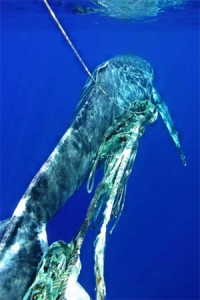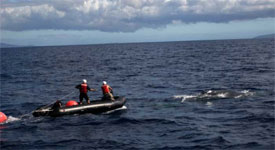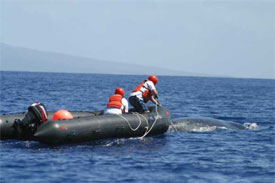
Whale entanglements have repeatedly occurred over the past several years. Here we present summaries on recent entanglements and general information on the issue.
In April 2012, a 40′ gray whale in its northern migration was spotted off Laguna Beach, with up to 100 feet of fishing line wrapped around one of its pectoral fins and tangled up inside the whale’s mouth. A team was able to remove part of the fishing line, but lost the whale before they could finish. The same whale resurfaced a week later, several hundred miles up the coast, off the coast of Big Sur near Lucia. Before another team could head out and cut away the rest of the fishing gear, the whale disappeared again. The mobility-impaired whale attracted broad media interest, but was not sighted again despite search efforts by NOAA and the Whale Entanglement Team (WET), a private rescue group operating under a NMFS permit.
In May 2011, staff of Monterey Bay Whale Watch captured video of an entangled humpback whale passing close to the whale watching vessel Sea Wolf II. The whale appeared to be tangled up in netting. The whale was not sighted again and a rescue was not performed.
On May 10, 2008, a sub-adult humpback whale (Megaptera novaeangliae) was found entangled in what was believed to be local crab fishing gear line in northern Monterey Bay. Members from the local disentanglement network, authorized by the National Marine Fisheries Service, responded. However, after assessing the animal it was determined that the entanglement was not presently life threatening and not likely to become so in the future. It appeared that the entanglement was once more involved and over time the whale had thrown most of the entanglement and was very likely to throw the last remnants in short order. Since any disentanglement effort can be dangerous for the whale as well as the rescuers, it was determined that the animal was not a candidate for a disentanglement effort. As much as possible, progress of this animal will be monitored and the action plan revaluated if necessary.

California national marine sanctuaries play host to several thousands of endangered whales including Humpbacks and Blue whales (Balaenoptera musculus) during the summer and fall months, and Gray whales (Eschrichtius robustus) from winter to spring. These animals migrate or swim close to shore directly in heavily fished waters, increasing their chances of getting entangled in fishing gear such as crab/lobster pot lines, drifting nets or other such obstacles.
From 2004-2008, a total of 18 Humpback whales were observed entangled in fishing gear in California, Oregon, and Washington. Of these, 11 were reported entangled in trap/pot fishery gear off California and Oregon, including two animals later found dead in Oregon. Two of the 11 pot/trap gear entanglements were attributed to specific fisheries, as one whale was entangled in sablefish trap gear and another in spot prawn trap gear. The other seven Humpbacks were reported entangled in unknown gillnet or other gear, including lines and buoys of unknown origin. Two of the 18 Humpbacks were successfully disentangled.

Entanglement, while most publicized in whales, affects all cetaceans (whales, dolphins and porpoises) by reducing their ability to feed and deteriorating their health in general. Entanglement hinders swimming ability, resulting in drowning or vulnerability to boat strike and the physical trauma from the injuries can lead to infection and subsequent death of the animal. Whale entanglement is a serious threat facing whales and cetaceans. An estimated 300,000 cetaceans die each year from entanglement in fishing gear, indicating that fisheries by-catch is the single greatest human-related cause of cetacean mortality.
WHAT YOU CAN DO
- Within Monterey Bay National Marine Sanctuary, to report an entanglement for any marine mammal or sea turtle, call the Coast Guard on VHF Channel 16 or the California Entanglement Hot Line: 1 800 853-1964 (for marine mammals and sea turtles).
- If the initial information you provide suggests a response should be mounted and conditions (weather, sea state, time of day) allow for such a response, please remain with the animal. A large whale is essentially a large needle in a very big haystack. Once lost, they are rarely re-located.
- DO NOT ATTEMPT TO DISENTANGLE THE WHALE YOURSELF
For more information, check these resources:
Carretta, J. V., K. A. Forney, E. Oleson, K. Martien, M. M. Muto, M. S. Lowry, J. Barlow, J. Baker, B. Hanson, D. Lynch, L. Carswell, R. L. Brownell Jr., J. Robbins, D. K. Mattila, K. Ralls, and M. C. Hill. 2010. US Pacific Marine Mammal Stock Assessments: 2010. NOAA Technical Memorandum, NOAA-TM-NMFS-SWFSC-476.
May 2011 video shot by Monterey Whale Watching Center
April 2012 videos, interview with MBNMS Superintendent Paul Michel
LINKS to other web sites for more information:
NOAA’s Marine Mammal Health and Stranding Response Program
Article on knives used to cut off entangled rope